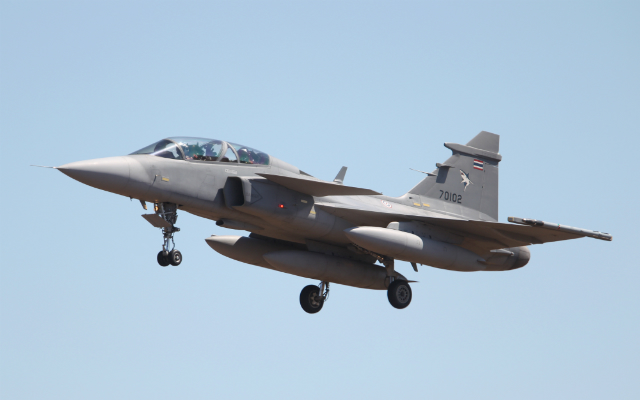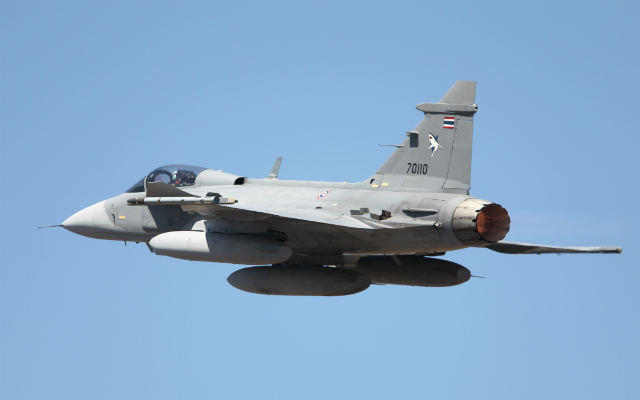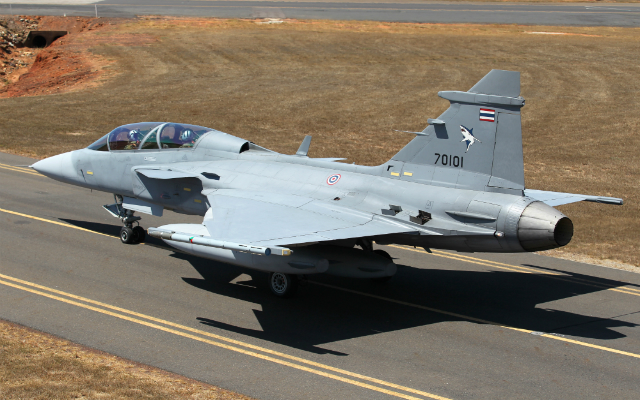Thailand's air force has deployed its Saab Gripen C/Ds to Darwin in northern Australia for Exercise Pitch Black 2014 (PB14), in the type’s first overseas exercise deployment by the service.
The Royal Thai Air Force has previously deployed its Lockheed Martin F-16A/Bs to Pitch Black since it first attended the biennial exercise in 2004. The Gripen entered Thai service in 2011, and since then the air force had only displayed the aircraft at the LIMA defence show in Malaysia, and the BRIDEX event in Brunei.
The deployment to Darwin was conducted without tanker support, with the four single-seat fighters and two twin-seat aircraft flying from Surat Thani air base to Darwin via an overnight stop in Singapore and a refuelling stop in Bali.

Andrew McLaughlin
Flying with the ‘shark’ callsign, the Gripens have been conducting primarily air-to-air missions at PB14, carrying simulated Raytheon AIM-120 AMRAAM and AIM-9X missiles for blue force offensive counter-air and red force defensive counter-air missions. “It’s a new jet and can do multi-role missions, but we thought we would take it easy by doing only air-to-air missions for this first time,” 701 Sqn commander, Wg Cdr Chareon ‘Tonic’ Watanasrimongkol told media in Darwin.
The six Gripens have continued to fly without tanker support, instead using three auxiliary fuel tanks for their two daily missions of up to 2.5h over the vast Bradshaw and Delamere Ranges south of Darwin. The aircraft have enjoyed good availability during this time, only dropping their first mission due to aircraft unserviceability 10 days into the exercise.

Andrew McLaughlin
The Thai detachment brought 15 pilots to PB14, with only five of them having previously attended a Pitch Black event. “One of our main objectives is to give the pilots a big learning from the exercise in terms of fighting with Gripen with international forces in multi-link networked scenarios,” Watanasrimongkol explains.
The Gripen compares very favourably to Thailand’s F-16 Block 15 fighters, which are undergoing a mid-life upgrade to a standard similar to Lockheed's international Block 50 configuration. “Performance-wise they are very similar, but avionics-wise it’s a different world,” he says. “These are different generation aircraft: Gripen is much better in terms of the human-machine interface, and with the datalink system this increases the SA [situational awareness] of the pilots a lot.”

Andrew McLaughlin
Host-nation Australia is participating with 26 Boeing F/A-18A/B Hornets, eight F/A-18F Super Hornets, two Airbus Defence & Space KC-30/A330 multi-role tanker/transports, a Boeing E-7 airborne early warning and control (AEW&C) system aircraft, and Lockheed C-130J Hercules and Beechcraft King Air 350 transports.
International participants include Singapore, which is flying eight F-16C/Ds and six Boeing F-15SGs, a Boeing KC-135R tanker, and a Gulfstream/Israel Aerospace Industries G550 AEW&C; the United Arab Emirates, with six Dassault Mirage 2000-5s and one A330 tanker/transport; the US Air National Guard with 10 F-16C Block 30 fighters, the US Air Force with Guam-based Boeing B-52H bombers, and the French air force, with an Airbus CN235 transport.
Source: FlightGlobal.com



















